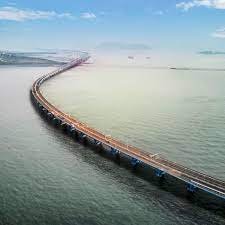The Mumbai Trans Harbour Link (MTHL), inaugurated by Prime Minister Narendra Modi, is one of India’s longest sea bridges, dedicated to former Prime Minister Atal Bihari Vajpayee. Learn about the various technologies used to build the bridge.
Prime Minister Narendra Modi inaugurated the six-lane Mumbai Trans Harbour Link (MTHL), one of the longest maritime crossings. 21.8 km long bridge dedicated to late prime minister Atal Bihari Vajpayee and built with Rs 18,000 crores is a major infrastructural achievement of the country.
It is the longest sea bridge designed to improve regional transit and connectivity. The new bridge, erected in a record five years, shows the country’s engineering progress. Technology made the new Atal Setu Bridge more efficient and environmentally friendly. MMRD metropolitan commissioner Sanjay Mukherjee said it was the first time Indian engineers employed the tech for construction.
India TV—atal setu, tech news, engineers
Image from X/NARENDRA MODIEAtal Setu engineers with PM Modi
These 8 technologies make Atal Setu Bridge an engineering marvel.
Noise reduction: The bridge has side noise barriers and silencers to reduce noise.
Sustainable lighting: The bridge's energy-efficient LED lights are designed to minimize aquatic environment damage.
Open road tolling: The bridge employed modern electronic toll collection (ETC) technology to automatically collect tolls from cars. Stopping is eliminated further. Additionally, this reduces toll booth traffic.
The bridge uses base isolation bearings as shock absorbers to withstand earthquakes. This allows controlled movement during earthquakes without collapse. The novel design can resist Richter scale tremors up to 6.5.
Real-time traffic info: Atal bridge vehicles will see displays showing traffic conditions and accidents on the bridge and nearby roads.
The bridge deck's corrugated steel plate supports a network of steel beams for structural strength and increased spans. Compared to concrete decks, the steel deck reduces the bridge's weight and improves its wave and wind resistance.
Longer spans: The steel deck claims to allow longer spans between support piers, reducing the number of piers and improving bridge aesthetics. Unlike concrete, the deck is easy to inspect and maintain.
Special reverse circulation rigs reduce vibrations and noises, protecting marine life near the bridge.Conclusion
Prime Minister Narendra Modi opened the Mumbai Trans Harbour Link (MTHL), one of India’s longest sea bridges, in honor of former Prime Minister Atal Bihari Vajpayee. The 21.8 km, Rs 18,000 crore bridge was erected in a record five years.
The Atal Setu Bridge is an engineering wonder built employing advanced technologies. Noise reduction, eco-friendly lighting, open road tolling, earthquake-resistant design, real-time traffic information, lightweight steel deck, larger spans, and reverse circulation rigs are included. The revolutionary bridge design allows controlled movement during earthquakes without collapsing. The bridge’s steel deck is lightweight, easy to inspect, and maintain, decreasing its weight and wave and wind resistance.



